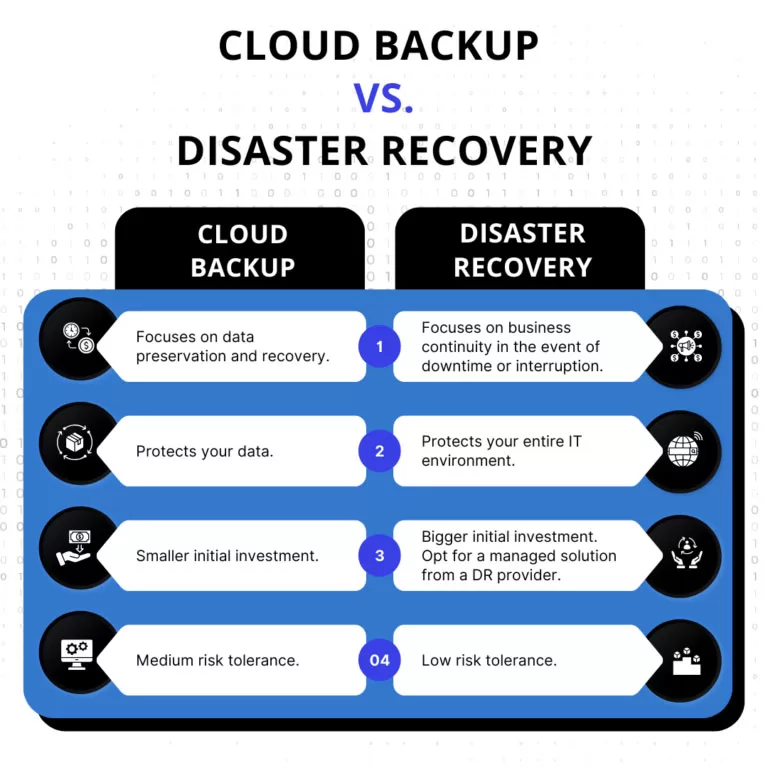In the digital world we live in today, data has become the backbone of businesses, hence the rise in popularity of cloud backup and Disaster Recovery as a Service (DRaaS) solutions. These two solutions play distinct roles in safeguarding your organisation’s data. Let’s dive into their fundamental differences and their respective roles in data security.
What Is Cloud Backup?
Cloud backup is a data protection strategy that involves copying and storing your organisation’s data in a secure, remote cloud location. This process ensures that your critical information is safe from various threats, such as hardware failures, data corruption, accidental deletion, and cyberattacks.
Benefits of Cloud Backup for Businesses
Accessibility: Your data is accessible from anywhere, as long as you have an internet connection. This makes it easy to recover lost files or access data during emergencies.
Data Redundancy: Cloud backup ensures that your data is stowed in multiple locations, massively reducing the risk of data loss.
Cost-Effective: It eliminates the need for on-premises hardware and maintenance costs associated with traditional backup solutions.
Scalability: You can easily scale your storage needs up or down based on your organisation’s requirements.
Data Security: Leading cloud providers implement robust-security measures to protect your data from unauthorised access and cyber-threats.
Business Continuity: Cloud backup helps ensure business continuity by enabling data recovery in case of data loss incidents.
What is Disaster Recovery as a Service (DRaaS)?
Disaster Recovery as a Service (DRaaS) is a comprehensive solution that goes beyond data preservation. DRaaS focuses on ensuring business continuity in the event of a disaster, whether it’s a natural catastrophe, cyberattack, or any other disruptive event.
Benefits of DRaaS for Businesses
Minimal Downtime: DRaaS significantly reduces downtime in the event of a disaster, minimising the impact on your operations and customers.
RTO and RPO Flexibility: You can tailor recovery time objectives (RTO) and recovery point objectives (RPO) to meet your specific business needs.
Comprehensive Protection: DRaaS protects not only your data but also your entire IT environment, including applications and systems.
Cost Savings: While DRaaS may involve an initial investment, it often proves more cost-effective than building and maintaining an in-house disaster recovery infrastructure.
Peace of Mind: Knowing that your business can quickly recover from any disaster gives you peace of mind and allows you to focus on growth rather than worrying about data loss and downtime.

Choosing the Right Solution for Your Business
Now that we’ve outlined the differences between cloud backup and DRaaS, how do you decide which one is right for your business? The choice depends on several factors:
Data Criticality: Consider how critical your data is to your business. If data loss is unacceptable, DRaaS might be the better choice due to its rapid recovery capabilities.
Recovery Time Objectives (RTOs): Determine how quickly you need to recover your systems and data. If you have strict RTOs, DRaaS provides quicker recovery.
Compliance Requirements: If your industry has specific compliance regulations regarding data protection and disaster recovery, make sure your chosen solution aligns with these requirements.
Risk Tolerance: Assess your organisation’s tolerance for downtime and data loss. DRaaS offers lower RPOs and RTOs, reducing both downtime and data loss.
Testing Needs: If you require regular testing and simulation of disaster scenarios, DRaaS can facilitate this process.
Conclusion
Cloud backup and DRaaS are both essential tools for safeguarding your organisation’s data, but they serve different purposes. Cloud backup focuses on data preservation and is a cost-effective option for businesses looking to protect their critical information. On the other hand, DRaaS takes data protection to the next level, ensuring business continuity by providing rapid recovery and system replication capabilities.
Choosing between these solutions requires a careful assessment of your business’s specific needs, budget, and risk tolerance. Whether you opt for cloud backup or Disaster Recovery as a Service (DRaaS), the key takeaway is that investing in data protection is not just a choice, but a necessity in today’s digital landscape. By doing so, you can ensure that your business is resilient, secure, and ready to face any challenges that come its way.